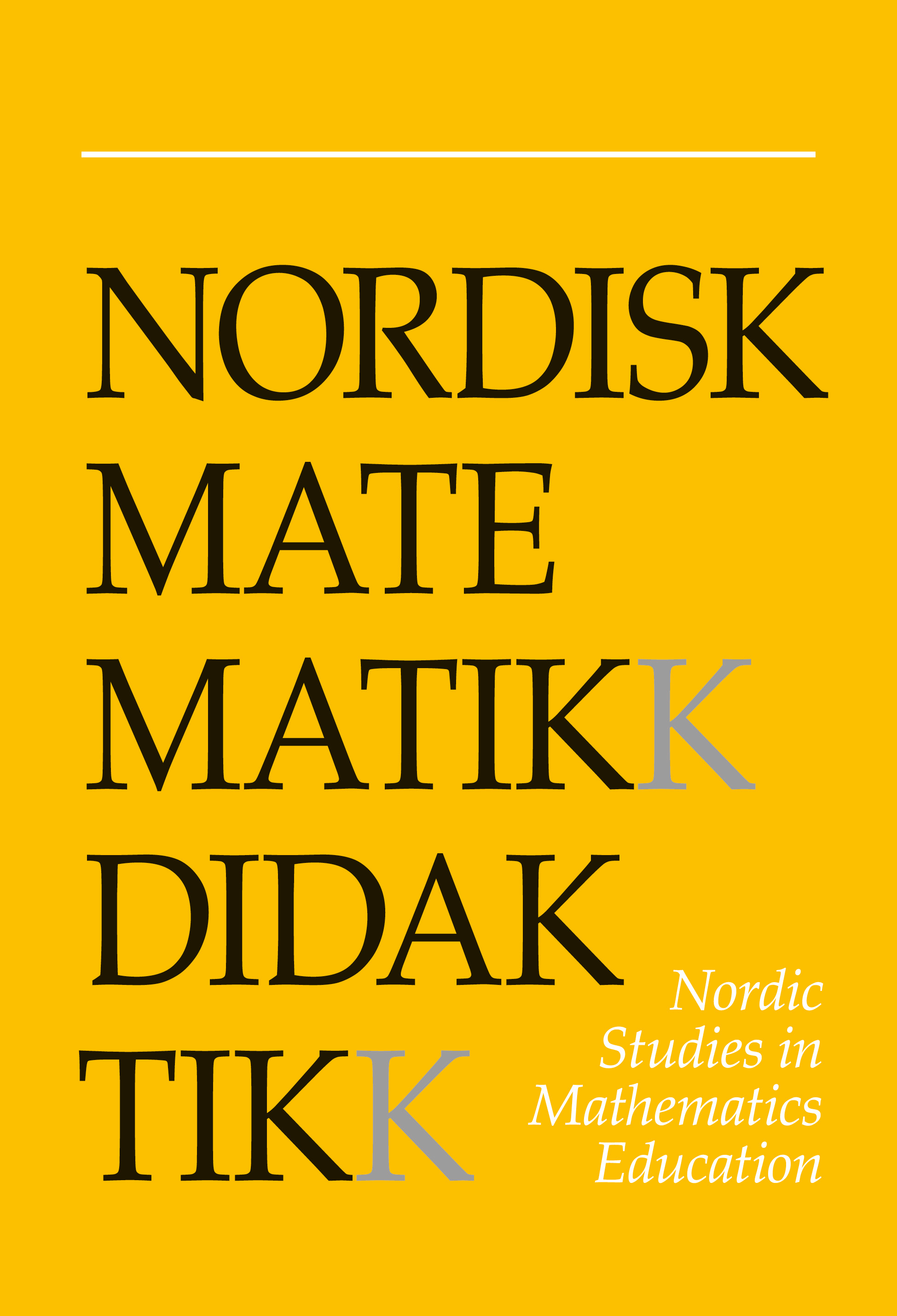Cooperation and collaboration as zones of proximal development within the mathematics classroom
DOI:
https://doi.org/10.7146/nomad.v15i2.148243Abstract
Beyond understanding the Vygotskian construct of zone of proximal development or ZPD with reference to an individual student, this paper explores the formation of ZPD within the pedagogical constructs of cooperation, wherein students cooperate with each other within their groups; as well as collaboration, wherein students from different groups that constitute the classroom collaborate with each other. Identified on the basis of functions that are in the process of maturing, the formation of either ZPD is exemplified from a socio-cultural-historical study at an upper secondary mathematics classroom in Norway. An emphasis on what distinguishes events in instruction that are educational from those that are not is also explored, before illustrating what nature of ZPD is established. The role of guidance received, imitation and cultural resources in the development of higher mental functions is understood as these ZPD are formed, enabling students to act independently within the classroom teaching-learning of mathematics.
References
Abreu, G. de. (2000). Relationships between macro and micro socio-cultural contexts: implications for the study of interactions in the mathematics classroom. Educational Studies in Mathematics, 41, 1-29. https://doi.org/10.1023/A:1003875728720
Albert, L. R. (2000). Outside-in - inside-out: seventh-grade students' mathematical thought processes. Educational Studies in Mathematics, 41, 109-141. https://doi.org/10.1023/A:1003860225392
Bodrova, E & Leong, D. J. (2007). Tools of the mind - the Vygotskian approach to early childhood education. Upper Saddle River: Pearson Education.
Bruner, J. (1984). Vygotsky's zone of proximal development: the hidden agenda. In B. Rogoff & J. V. Wertsch (Eds.), Children's learning in the "Zone of proximal development" (pp. 93-97). San Francisco: Jossey-Bass. https://doi.org/10.1002/cd.23219842309
Chaiklin, S. (2003). The zone of proximal development in Vygotsky's analysis of learning and instruction. In A. Kozulin, B. Gidnis, V. S. Ageyev & S. M. Miller (Eds.), Vygotsky's educational theory in cultural context (pp. 39-64). Cambridge University Press. https://doi.org/10.1017/CBO9780511840975.004
Cole, M. (1985). The zone of proximal development: where culture and cognition create each other. In J. V. Wertsch (Ed.), Culture, communication, and cognition: Vygotskian perspectives (pp. 146-161). Cambridge University Press.
Forman, E. A. & McPhail, J. (1993). Vygotskian perspective on children's collaborative problem-solving activities. In E. A. Forman, N. Minick & A. C. Stone (Eds.), Contexts for learning: sociocultural dynamics in children's development (pp. 213-229). New York: Oxford University Press. https://doi.org/10.1093/oso/9780195067156.003.0011
Gade, S. (2006). The micro-culture of the mathematics classroom: artefacts and activity in meaning making and problem solving (Doctoral dissertation). Kristiansand: Agder University College.
Goos, M., Galbraith, P. & Renshaw, P. (1999). Establishing a community of practice in a secondary mathematics classroom. In L. Burton (Ed.), Learning mathematics: from hierarchies to networks (pp. 36-61). London: Routledge.
Goos, M., Galbraith, P. & Renshaw, P. (2002). Socially mediated metacognition: creating collaborative zones of proximal development in small group problem solving. Educational Studies in Mathematics, 49, 193-223. https://doi.org/10.1023/A:1016209010120
Lerman, S. (2001). Cultural, discursive psychology: a sociocultural approach to studying the teaching and learning of mathematics. Educational Studies in Mathematics, 46, 87-113. https://doi.org/10.1023/A:1014031004832
Oldervoll, T., Orskaug, O. & Vaaje, A. (2001). Sinus Matematikk: #mxy Grunnbok. Oslo: Cappelens Forlag
Stetsenko, A. P. (1999). Social interaction, cultural tools and the zone of proximal development: in search of a synthesis. In S. Chaiklin, M. Hedegaard & U. Juul Jensen (Eds.), Activity theory and social practice: cultural historical approaches (pp. 235-252). Aarhus University Press.
Stetsenko, A. P. (2004). Introduction of "Tool and sign in the development of the child". In R. W. Rieber & D. K. Robinson (Eds), The essential Vygotsky (pp. 501-512). New York: Kluwer Academic/Plenum Publishers.
Strauss, A. L. (1995). Research issues and an interactionist theory of action. Mind, Culture, and Activity, 2, 18-28. https://doi.org/10.1080/10749039509524682
Tudge, J. (1990). Vygotsky, the zone of proximal development, and peer collaboration: implications for classroom practice. In L. C. Moll (Ed.), Vygotsky and education: instructional implications and applications of sociohistorical psychology (pp. 155-172). New York: Cambridge University Press. https://doi.org/10.1017/CBO9781139173674.008
Van der Veer, R. (2007). Lev Vygotsky. London: Continuum.
Vygotsky, L. S. (1978). Mind in society: the development of higher psychological processes. Cambridge: Harvard University Press.
Vygotsky, L. S. (1997a). Educational psychology. Boca Raton: St. Lucie Press.
Vygotsky, L. S. (1997b). The collected works of L. S. Vygotsky: Volume " - the history of development of higher mental functions. New York: Plenum Press.
Wertsch, J. V. (1984). The zone of proximal development: some conceptual issues. In B. Rogoff & J. V. Wertsch (Eds.), Children's learning in the "Zone of proximal development" (pp. 93-97). San Francisco: Jossey-Bass. https://doi.org/10.1002/cd.23219842303
Wertsch, J. V. (1991). Voices of the mind: a sociocultural approach to mediated action. Cambridge: Harvard University Press.
Downloads
Published
How to Cite
Issue
Section
License

This work is licensed under a Creative Commons Attribution-NonCommercial-ShareAlike 4.0 International License.



